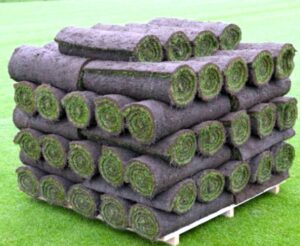Six Steps to a Fantastic Lawn
Here at Sherborne Turf, we’re really proud to have been growing turf and looking after lawns locally for 50 years this year. As experienced growers we are always happy to share our knowledge and advice.
After a summer of heat and drought (and little that can be done for your lawn), it’s now time to get busy with lawn repairs!
For us, autumn is an incredibly important time for lawn care and in many cases, October is the last opportunity to get your lawn ready for the winter ahead. With the days getting shorter, the temperatures getting cooler and the possibility of an increase in rainfall, it can seem as if there’s so much to do in so little time, but Sherborne Turf has all the advice you need to get everything sorted. Follow our six simple steps to get your lawn ready for the winter:

- Scarify
Put simply, rake your grass. If you have a look at your lawn, you’ll probably notice a layer of light brown debris, called thatch, covering the soil that can easily be removed. This will have served a purpose during the hot summer we’ve had, protecting the roots from the heat of the sun, and helping to retain the little water left in the soil. As the weather cools, however, it becomes important to remove the thatch in order to let light, water, fertiliser and seed through.
Removing this layer is easy to do with a good quality rake. Simply rake away as much of the thatch as possible. For larger areas, an electric powered scarifier may make life easier. If it’s the first time you’ve done this, it can be a little daunting to see how much comes away as you rake but persevere to give your lawn the best chance of recovery.
Removing the thatch layer from the lawn will minimise disease in the coming winter months by reducing the material pathogens need to thrive.
- Aerate
After scarifying, you’ll be able to see the quality of the soil beneath. There’s a strong chance it will be compacted due to heavy use over the spring and summer. This means it is solid and pressed together so water will struggle to reach the grass roots and will just run off the surface. This may in turn lead to water logging. To prevent this, aerate or spike your lawn using a lawn aerator with solid tines or spikes. After a drought it is a good idea to use something with narrower spikes – items such garden forks with larger tines may not help. Make sure you aerate before fertilising your lawn.
- Fertilise
With the cooler weather and heavier rainfall, autumn is the perfect time to apply fertiliser or conditioner. This will protect the lawn over the winter months. The best fertiliser will be lower in nitrogen and higher in iron, such as Sherborne Turf’s Green and Black Fertiliser.
If you are not sure which option is best for you, have a look at our handy guide online, or give us a ring on 01935 850388 for advice.
October is also the perfect time to use soil conditioner, which purifies the soil, improving root mass and nutrient uptake while increasing resistance to disease and pests, protecting the lawn as it enters the dormant period.
- Improve the surface
If you have aerated your lawn and feel that the surface needs evening out, an application of top-dressing will smooth the lawn surface and correct any irregularities. A mixture of sand and compost will help improve drainage whilst stimulating healthy grass growth and improving the appearance of the lawn’s surface.
- Re-seed
Down in the Southwest of England, we have a lot longer to sow grass seed should we need to, though October is often the last opportunity. Keep an eye on the weather as particularly heavy rainfall or cold temperatures will prevent germination, where light rainfall and warmer temperatures will encourage it.
- Mow
It is important to continue mowing your lawn throughout the colder months. We would recommend cutting little and often, then collecting the cuttings and any leaf fall to keep for compost and mulch. Don’t mow when the grass is wet as this can spread disease such as red thread, as well as potentially damaging your mower.

Feel Your Lawn is Beyond Repair?
If you’ve decided to lay new turf, autumn is the perfect time to do so. Thanks to the cooler, wetter weather, a newly laid lawn has the perfect opportunity to establish good root growth without growing too quickly (which it would do in warmer months). Higher rainfall means you would need to use less water. Shorter days means people will be spending less time outside walking across the grass, avoiding compaction.
If you are planning on laying new turf, remember to prepare the ground thoroughly first, removing larger stones and applying a layer of fertiliser such as our http://Stripy Green Fertiliser. After the turf is laid, remember to ensure it is well watered (so keep an eye on the weather), avoid walking on it, and give the lawn about three weeks to take root before mowing. When you mow for the first time, keep the mower at its highest setting to avoid stressing the grass, then cut little and often through the winter months. You can find more advice on how to lay turf online at https://www.sherborneturf.co.uk/
Remember, if you establish good lawn maintenance now, it will pay off as the weather warms up again next year. If you’d like further advice, feel free to get in touch on 01935 850388, or if you need further assistance with establishing a new lawn or improving your garden, contact our landscaping company, Queen Thorne Landscapes online at http://www.queenthorne.garden, by email to office@queenthorne.co.uk, or by phone on 01935 850388.




